|
The Recession
The loss of life in
the First World War had been horrific.
745,000 servicemen and 24,000 civilians
were killed and 1.7 million people were
wounded.
The war had been
funded by selling foreign assets, and
borrowing billions of pounds from the
U.S.A. which led to a large national
debt. Britain’s interest payments
amounted to around forty percent of the
national budget. In 1920 the rate of
inflation was twice as high as in 1914,
and the value of the pound fell.
Immediately after
the war, there was a short-lived boom in
the economy, which lasted until late in
1919, but things rapidly changed. During
the war around 7.9 million tons of
shipping had been lost and so in 1919 to
1920 there was much investment and a
rush of orders for replacement ships,
but this soon ended.
The early 1920s
were a time of recession, a time of
hardship for many people. The First
World War greatly stretched the nation’s
finances. It disrupted our trade, and
led to the rise of foreign competition,
and the loss of many of our traditional
exports, including steel, coal, and
textiles. The country had previously
grown wealthy because of its pre-eminent
trading position in the world, the loss
of which, led to the decline of many of
our once great industries, and
substantial job losses.
|
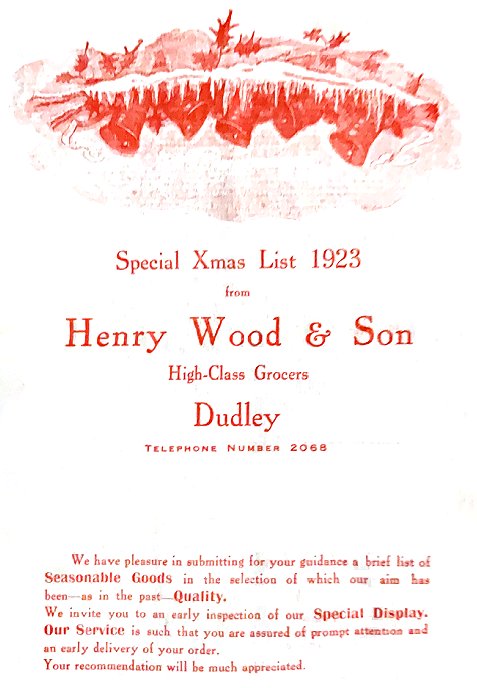
Courtesy of
Fiona Wasdell-Bowyer. |
In 1921 and 1922,
exports fell to half of the pre-war
levels and over 3 million people were
unemployed. Overall growth averaged 1.8
percent per annum during the 1920s and
by 1929 exports were still only 80
percent of what they had been in 1913.
There
was mass unemployment, much
bad housing, poor health and
for many people a sense of
hopelessness. The working
hours for industrial workers
was reduced to 48 hours per
week.
Industrial action
in the coal mining industry led to the
General Strike in 1926. The miners were
joined by a million railwaymen,
transport workers, printers, dock
workers, iron workers and steel workers.
The strike lasted for nine days and in
1927 the Trade Disputes and Trade Unions
Act made general strikes illegal.
Many new industries
appeared in the 1920s, which helped to
ease the situation. One of the
industries, helped by the latest
mass-production techniques was vehicle
manufacturing, which led to the success
of A. Harper, Sons & Bean Limited, the
local car manufacturer at Waddams Pool
Works and at Tipton. |
Other successful
industries included electrical
engineering, mechanical engineering,
metal goods, and printing. The sales of
electrical appliances also grew thanks
to the rise of consumer credit and
loans.
As the 1920s
progressed, higher wages and shorter
working hours also led to the rise of
recreation. People loved listening to
the recently introduced wireless, and
the more affordable gramophone records.
Magazines were popular, as was going to
the theatre and the new cinemas. People
also had more time to participate in
sports such as football and cricket.
Industrial
relations began to improve, but another
shock occurred in October 1929. The Wall Street
Crash caused a worldwide depression. The UK
suffered badly, with over 3 million
people unemployed by the beginning of
1933. The situation did slowly improve.
By 1938 the unemployment figure had
halved, and as war became increasingly
likely, industry again benefitted from
essential war work and jobs became
plentiful.
| |
|
|
Images
of Dudley, as seen on old
postcards |
 |
| |
|
Municipal Housing
Dudley, like its
neighbouring towns, had many slum
properties. Plans were made to improve
local housing conditions by the building
of council houses, which would allow the
areas of slum housing to be redeveloped.
A few council houses had been built by
1916 at Kate’s Hill, but further
building work ceased until after the
war.
|
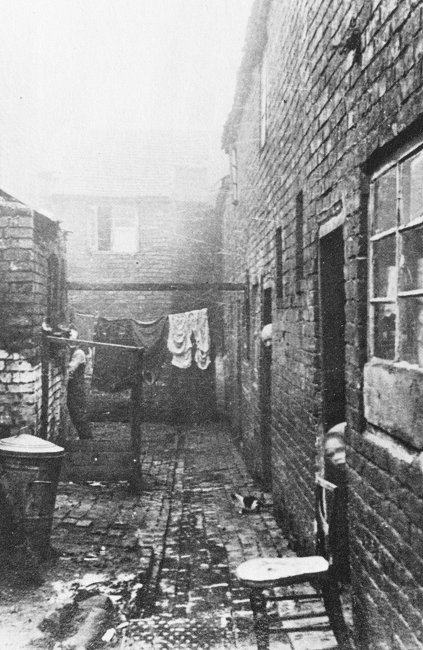
One of
the slum courtyards off
Birmingham Street. From an
old postcard. |
The post war Housing Acts gave
local authorities the necessary powers
to build council houses and encouraged
them to do so.
By 1921 over 300 council
houses had been built at Kate’s Hill and
other new estates appeared at Blower’s
Green, Woodside, and Grazebrook Road.
The local population was noticeably
increasing and so more houses were
needed. In 1921 the population of Dudley
was 55,894. It had increased to
59,583 by 1931.
In 1928, an Act was
passed to enlarge Dudley to include
Dudley Castle and the Priory, which were
formerly in Staffordshire. This allowed
the council to build the Priory Estate
on land that had previously been part of
Sedgley.
The estate was completed in
1939. Around the same time, the council
built the neighbouring Wren’s Nest
Estate and the Grace Mary Estate at Oakham.
|
At the time, the
Priory Estate was Dudley Council’s
largest housing development in the area.
The foundation stone of the first house,
9 Oak Road, was laid on the 16th July,
1929. The first houses were occupied in
1930 and by the late 1930s over 2,000
houses had been built on the Priory and
Wren's Nest estates. The development
included shops in Priory Road, Lilac
Road and Thornhill Road. Most of the
inhabitants came from the old town
centre slums and were delighted with
their new amenities, including a garden.

Part of the Priory Estate.
From an old postcard.
By the 1980s both
the Priory Estate and Wren’s Nest Estate
began to get a bad reputation caused by
vandalism, litter, graffiti, drug
dealing and burglaries. The high crime
rate led to calls for both estates to be
demolished. In March 2004, Dudley
Register Office in Priory Park suffered
from an arson attack. The severe blaze
was put out by 100 firemen who had to
work the whole night to get it under
control. Another arson attack in April
2006 caused severe damage to the Duncan
Edwards public house in Priory Road,
which has since been demolished.
Residents in both of the estates were
re-housed in preparation for demolition
and most of the empty properties were
vandalised. People were delighted when
the houses were demolished and replaced
by the modern estate.
|
| |
|
| Read about
Entertainment:
Theatres and
Cinemas |
 |
| |
|
|
Priory Park
Priory Park opened
in July 1932, extending to the north and
the south of Priory Hall, covering an
area of 19 acres. The northern part
includes a bowling green, tennis courts,
a cricket pitch, a five-a-side football
pitch a basketball court, an
orienteering course and a children’s
play area. There is also the pavilion,
which is now a cafe run by Gather. It includes a community centre room, a
classroom for local schools, a changing
room, a refreshment area and a training
room. Nearby is another building that
houses Priory Park boxing club.

The Priory ruins.
To the south is
Priory Hall, now Dudley Register Office,
the rose garden, the lily pond, shrubs
and trees, and the ruins of St. James’s
Priory. Priory Hall was Grade II listed
on the 14th September, 1949 and Priory
Park was Grade II listed on the 7th
November, 2002. Restoration work was
carried out in the park in 2012 and
2013, funded by Dudley Council, the
Heritage Lottery Fund and the Big
Lottery Fund.

Priory Hall.

The Lily pond.
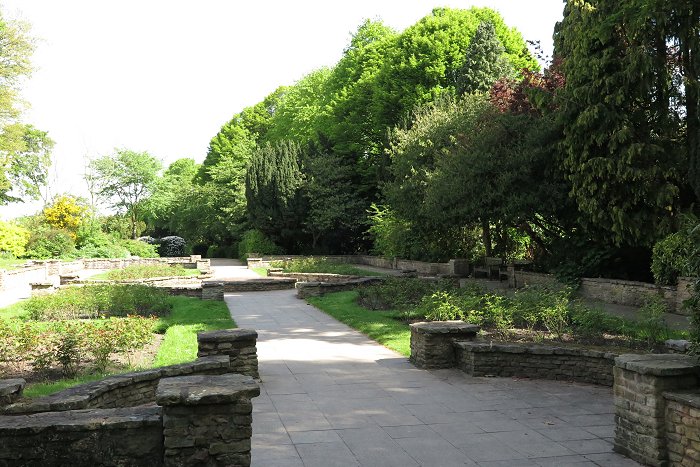
The rose garden.
Dorothy Round
Priory park also
contains a monument to one of Dudley’s
most successful sporting personalities,
the tennis star, Dorothy Round. She was
born on the 13th July, 1909 at 25 Grange
Road and attended Dudley Girls High
School. From an early age she played
tennis on a court in the back garden of
her home, with her three brothers. She
entered her first tennis tournament in
1925 at Pwllheli, then on the 7th
September of that year, entered and won
the Junior Worcestershire Championship.
She retained the Worcestershire singles
junior title in 1926 and gained the
doubles title in the same event. Also in
that year she reached the Junior Final
at Wimbledon. In 1927 she retained her
titles in the Worcestershire County Lawn
Tennis Tournament, also becoming mixed
doubles champion. |
|
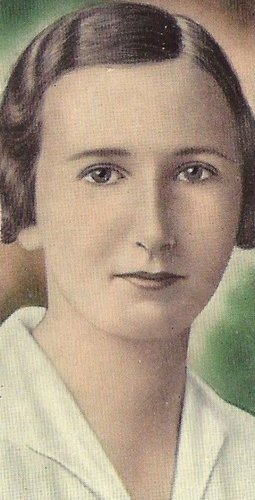
Dorothy Round. |
In 1930 she played
in the French Championships and was
being coached by Dan Maskell. She
reached the quarter final at Wimbledon
in 1931 and participated in the U.S.
National Championships. She was a member
of the British team in the Wightman Cup
and continued to compete in
championships, both at home and abroad.
1934 was a landmark year. In February
she competed in the Jamaican Tennis
Championships, as a member of the
British team and retained her British
Hard Court Championships single title in
Bournemouth. At Wimbledon she won the
ladies singles title and the mixed
doubles title. In November she competed
in New Zealand and Australia, winning
the Victorian Championships, at
Melbourne, in December.
1935 was also a
good year. She won the Australian
Championships in January, to become the
first overseas player to win the
competition and in the same month
released her first instructional book,
“Modern Lawn Tennis”. In the summer, she
retained her mixed doubles title at
Wimbledon and began working as a dress
designer and sports wear adviser to
Suzanne sportswear.
She was appointed
to the National Advisory Council of
Physical Fitness, in 1937 and in July of
that year won the singles title again at
Wimbledon. On the 2nd September, she
married Dr. Douglas Leigh Little, a GP.
And in the following year gave birth to
a boy, followed by a daughter in 1946.
More competitions followed and for a few
years she became a professional tennis
coach in Canada. |
| When her tennis-playing career was
over in 1950, she became a keen golf
player and played in several golf
tournaments. She became a sports
writer and wrote articles for several
British newspapers.
On the 4th April, 1958, her husband
died at their home in St. James’s Road,
Dudley and in August of that year she
was appointed a JP. in Dudley.
Dorothy died on the 12th November,
1982, at the age of 73, in
Kidderminster. |
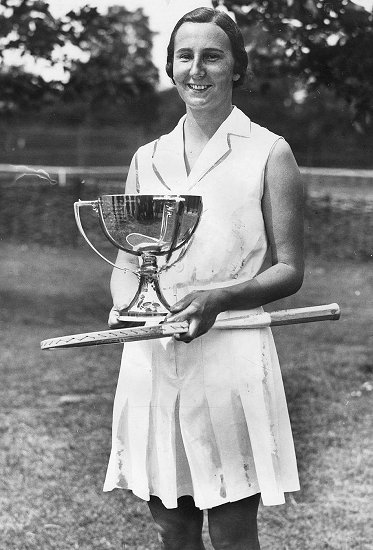
Dorothy Round. |
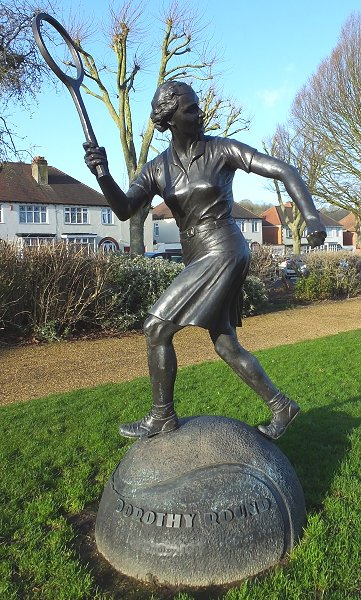 |
John McKenna's
wonderful bronze statue of Dorothy
Round, that was erected in Priory Park.
It was unveiled by
her daughter on the 20th September,
2013. The plinth has two inscriptions:
“The Return of
DOROTHY ROUND. Born Dudley 1909 Died
1982”
“Wimbledon
Champion Ladies Singles. 1934 and 1937.
Mixed Doubles 1934 1935 and 1937.” |
|
New
Town Hall and Council House
The Town Hall was
built between 1924 and 1928 as part of a
group of civic buildings, which includes
the coroner’s court, museum room, the
former magistrates’ court and the
memorial tower. The buildings were in
memory of Brooke Robinson and his wife,
Eugenia. Robinson was a prominent local
solicitor, who served as borough coroner
and also as the town’s Conservative MP
from 1886 until 1900. The building
included the Brooke Robinson museum that
opened in 1931 and housed much of his
vast collection, ranging from Roman
pottery to Japanese furniture and a
large number of oil paintings.
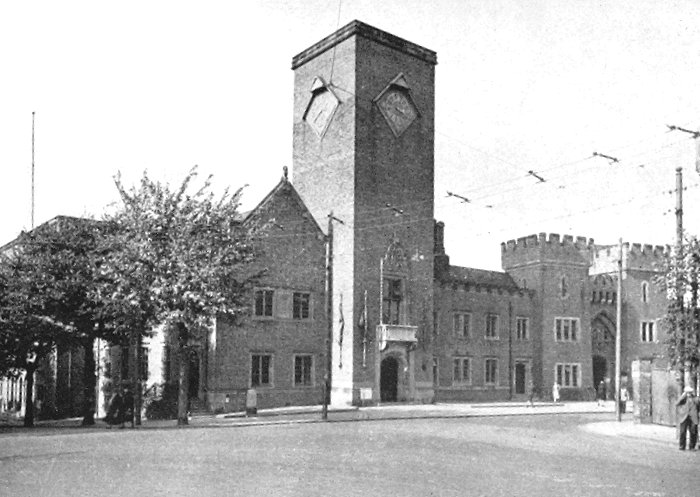
The Town Hall.
The buildings were
designed by the Birmingham firm of
architects, Harvey and Wicks, run by
partners William Alexander Harvey and
his nephew, H. Graham Wicks. They won a
competition for the design that
attracted 55 entrants. The buildings
occupied a rectangular site, between
Priory Road, Priory Street and St.
James’s Road, with the main entrance in
St. James’s Road. The buildings were
adjacent to the library buildings in St.
James’s Road, which opened in 1908 and
the police station that had been built
in 1847. A new police station was later
built in Tower Street, which opened in
1941, leaving the old building to be
used by the council.
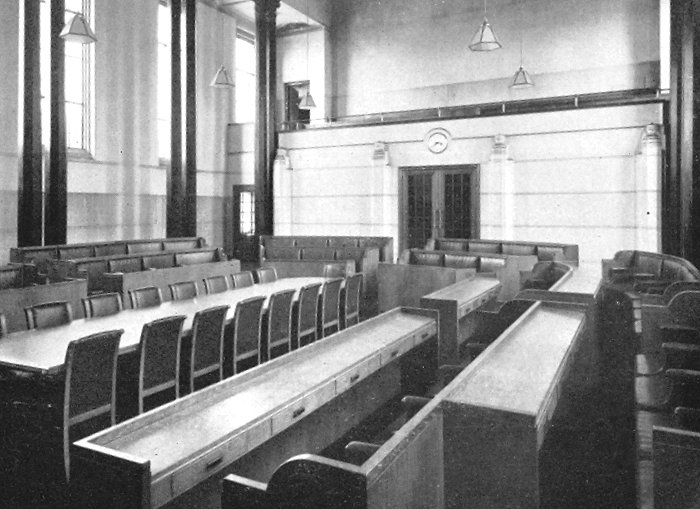
The Council
Chamber.
The Town Hall was
officially opened by the Prime Minister,
Stanley Baldwin, on the 16th October,
1928. It included the coroner’s court,
the sessions court, and the memorial
tower, inscribed with the names of the
700 men from Dudley who died in the
First World War. In 1934 work began on
the new Council House, which was built
with financial support from the Earl of
Dudley, who laid the foundation stone,
in June 1934. The building was also
designed by Harvey and Wicks and
officially opened by the Duke of Kent on
the 2nd December, 1935.
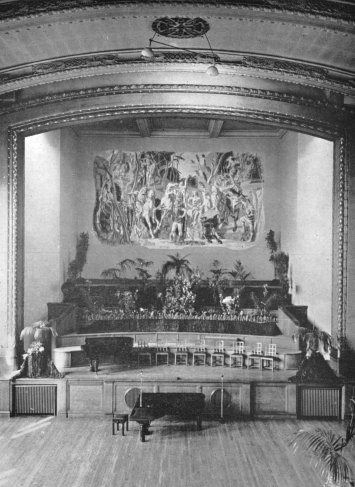 |
|
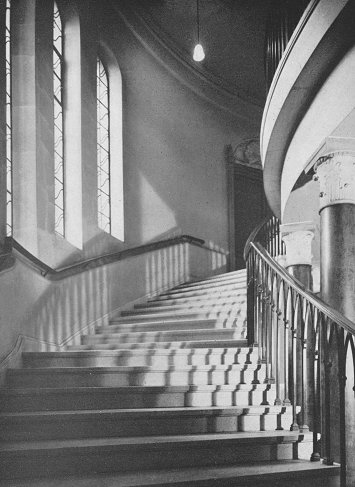 |
|
Proscenium Arch
in the Town
Hall. |
|
Staircase in the
Council House. |
|
The civic buildings
are all listed, as follows:
Public Library.
Grade II listed on the 9th April, 1976.
Council House. Grade II listed on the
23rd April, 2010.
Old Police Buildings and Former Sessions
Court. Grade II listed on the 14th
September, 1949.
Town Hall, Coroner’s Court, Former
Sessions Court and Brooke Robinson
Museum. Grade II* listed on the 14th
May, 2010.
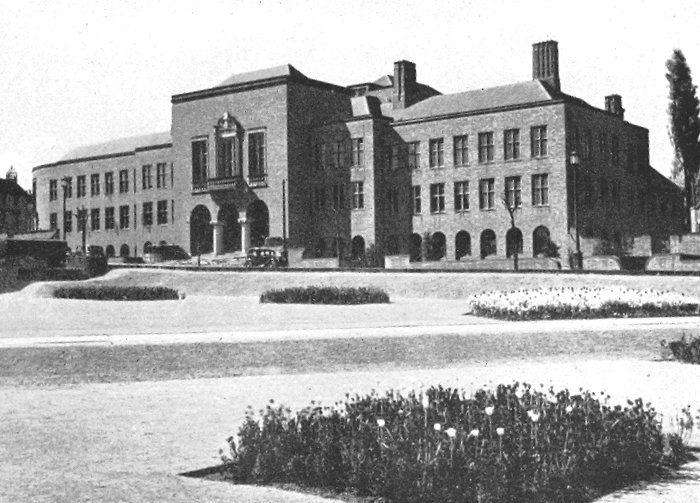
The Council House. |
|
The
Broadway
In the mid 1920s
plans were made for the building of a
bypass road from Castle Hill to Burton
Road. Work began in 1931 on the section
from Ednam Road to Priory Road and was
followed in 1932 by the remaining
sections. The road was named The
Broadway in November 1933, and
officially opened on the 1st May, 1935
by the mayor and other council members.
Carnival
Dudley’s first
carnival took place in September 1929.
Various events were held from Saturday
the 14th September to Saturday the 21st.
The carnival queen, Miss Joyce E.
Raybould, was crowned by the mayor, at
the castle on the Monday. During the
week there were football and cricket
matches, carnival dances, a swimming
gala and ox roasts. At the end of the
week, a grand carnival and trades
procession was held in the town. The
events raised over £5,000 for charity. |
|
Dudley Zoo
The Earl of Dudley
was thinking of ways to develop the
castle and its grounds into a resource
for the local community, a place where
people would want to visit. At the time,
Captain Frank Cooper, who owned Oxford
Zoo, wanted to sell his animals and
close the zoo, so the Earl had the idea
of converting the 40 acre site at Dudley
into a zoo.
The Dudley
Zoological Society was created in 1935
to oversee the project. The board
members were the Earl; Ernest Marsh, a
director of Marsh and Baxter; and
Captain Frank Cooper. The early meetings
were held at London Zoo, whose
Superintendent, Dr. Geoffrey Vevers
acted as an advisor. At the time,
Berthold Lubetkin, of the Tecton
Company, a Russian émigré, was designing
some impressive new enclosures at the
zoo and so he got the job of designing
the animal enclosures at Dudley.
The Earl wanted the
zoo to open in 1937 and so work quickly
got underway on the design and building
of 12 enclosures, made of pre-stressed,
reinforced concrete, forming curved
structures rather than squares or
rectangles. Most of the buildings were
erected in old limestone quarries around
the castle, which allowed visitors to
have spectacular views, looking down on
the animals. There was also the Queen
Mary Restaurant, built on the crest of
the hill. The castle had to be left
alone, because it is a Scheduled Ancient
Monument.
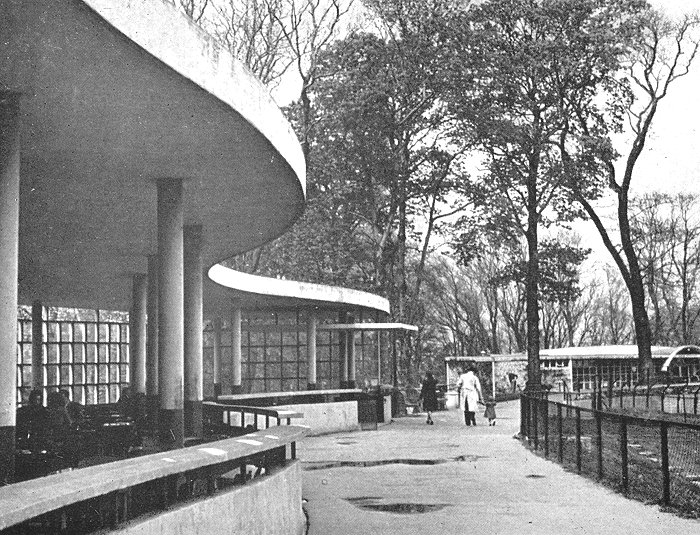
The cafe and the
restaurant in the late 1940s.
Oxford Zoo closed
in 1936 and its animals were transferred
to Dudley to form most of the initial
collection. The zoo opened in May 1937
and attracted over 250,000 visitors, but
only 50,000 could be admitted because of
health and safety. In its first year,
over 700,000 visitors passed through the
turnstiles. A narrow-gauge miniature
railway about a mile in length was added
in 1938 with two locomotives,
constructed by G & S Light Engineering,
of Stourbridge. Up to 150 passengers
could be carried at a time.
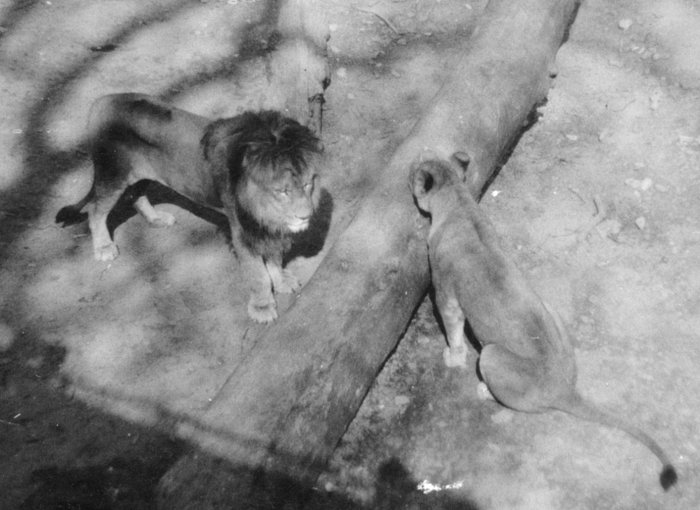
Looking down on
the lion enclosure in the 1960s.
The animal
collection included two Indian elephants
that gave people elephant rides, which
became very popular. There were three
peacocks given by the Duke of
Sutherland, four lions, two polar bears,
five tigers, several wolves and also
bison from Canada. Hamburg Zoo supplied
sea lions, zebras, bears, monkeys,
flamingos, pelicans and penguins. When
the zoo opened, the collection consisted
of around a thousand animals, including
over fifty kinds of mammals and a
hundred types of birds.
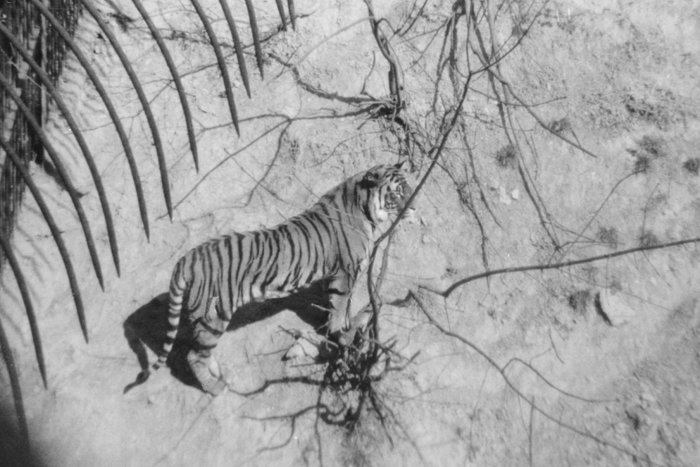
The tiger
enclosure in the 1960s.
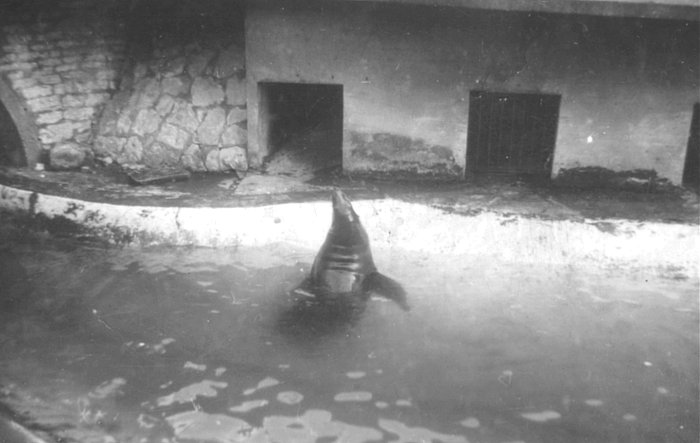
The sea lion pool
in the 1960s.
The chair lift was
added in May 1958 and opened by the
comedian Richard Hearne, better known as
Mr. Pastry. The zoo was purchased by the
Scotia leisure group in 1970, but ended
in receivership in 1977 and was
purchased by Dudley Metropolitan
Council. It was then operated by Dudley
and West Midlands Zoological Society,
formed in 1978. Berthold Lubetkin's
buildings are now on the statuary list.
Seven are Grade II listed and five are
Grade II* listed.
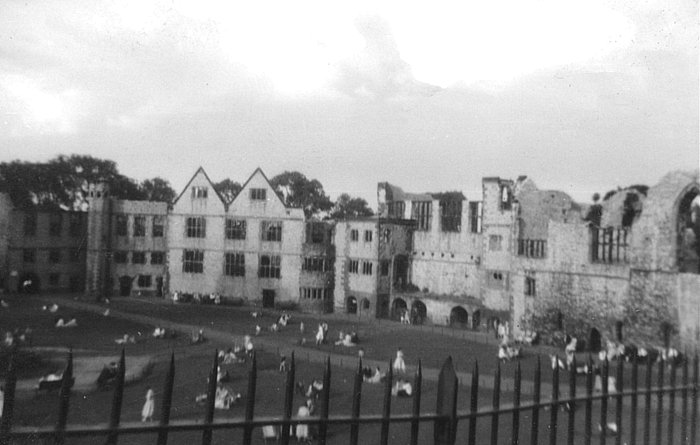
The castle
courtyard in the 1950s. |
 |
|
 |
|
 |
Return to the
First World War |
|
Return to
the contents |
|
Proceed to
World War 2 |
|